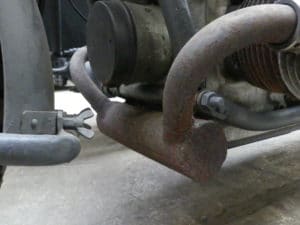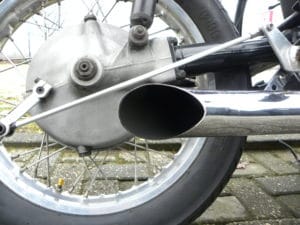Factory exhaust systems were never built for eternity. They must ensure optimal power delivery and maximum noise reduction during their lifetime. And that the interpretation of that value has often been interpreted differently over the years? So be it.
In the meantime, such an exhaust system is exposed to weather and wind, to heat and cooling, to vibrations and to chemical attack by acidic condensation after short journeys. And we are not even talking about dents and scrapes.
New original exhaust systems had their price
The supply market bravely dived into this. In the days of the European one and two cylinders, making an exhaust system was a fairly easy job for someone with a roller and a welding machine. That kind of simple replacement exhausts were therefore offered very early and for decent prices. And whether a 350 cc BSA now made more or less noise and whether it had gained an extra horsepower or had lost one? Pfah. Nice and important.
Everything changed with the arrival of the Japanese four-cylinder
Their exhaust systems were really designed for optimal gas flow and noise reduction. And the outside of the dampers was formed by pressed and welded shell parts, which had all kinds of dents, naps and holes to make room for brakes, center stands and bumper rubbers.
The entire design, construction and execution was based on mass production. And that is why the construction of expensive press molds was simply the right approach. Only: the average blacksmith could not make such a four-in-four set of Honda CB750 OHC silencers in an afternoon. And replace with original? That was expensive. Very expensive. Fortunately, there were almost no problems with engine noise at the time and the suppliers started making four-in-one systems en masse. They were cheaper and considerably lighter too. And that some copies were very loud? We liked that at the time!
More or less
In a comparison test in Das Motorrad, the Germans looked at a dozen four-in-one systems for the Kawa Z900. The best system delivered nearly as much power as the original set of pipes. The worst rated system lost a herd of 14 horses.
Meanwhile, those difficult Japanese bicycles are recognized as worth restoring. And those exhaust systems? The stock of NOS has since dried up. But there are a few investors worldwide who - of course in China - have had real serious press molds made again. That is why there are now new mufflers, real replicas including the correct numbers, for at least Honda CB450 K1s, CB750 OHCs, Kawasaki Mach IIIs 900 and - from the Netherlands! - Suzuki T500s
And that such a set of beautiful things can just be in the neighborhood of the two mille of rock hard euros? Well: better expensive than not for sale.




















delicious megatons on the laverda when the originals had fallen apart, Hoske pipes on the R75 / 5, on Sundays and holidays without an inner silencer, all was still possible in 1972, with my Sprint RS now almost ashamed of the noise I make
Yet such a BMW ran best on original pipes. But a BMW without a gag in its mouth sounds very nice indeed
Just scored a set of Arrows for my Aprilia RS250.
Aftermarket exhaust that adds a few horses to the howling riding school (so the stories say).
You could also talk to the gentlemen at 'London'; good, not cheap (because manual work) ..
Those are toppers. Don't they have the T500 / GT500 dampers in the program?